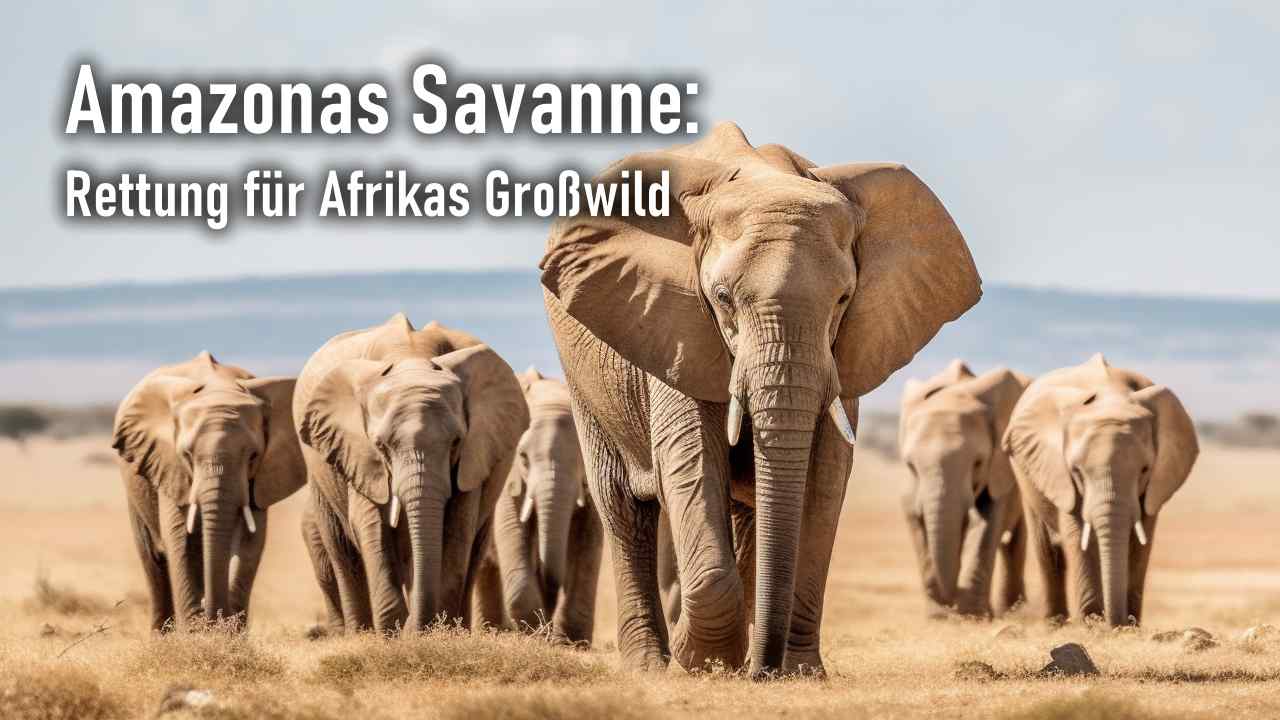
2141 Einführung der afrikanischen Big 5 in Südamerika

Afrikanisches Großwild wird in der Amazonas-Savanne angesiedelt.
Die Naturreservate Afrikas wurden in den vergangen 200 Jahren stark reduziert. Die meisten mussten schon im 21. Jahrhundert den Menschen weichen. Viele der großen Tiere Afrikas sind vom Aussterben bedroht oder sogar schon verschwunden. Der Leopard ist fast ausgestorben. Es gibt nur noch kleine, genetisch reduzierte Gruppen in Zoos. Büffel und Nashorn gibt es auch nicht mehr in freier Wildbahn, aber dafür größere Populationen als Nutztiere (Büffel für Milch und Fleisch, Nashörner für das Horn). Nur der afrikanische Elefant und die Löwen leben noch in freier Wildbahn. Beide Spezies werden sehr stark "verwaltet", ihre Wanderungen werden gesteuert und ihre Fortpflanzung unterstützt. Anderen großen Arten, wie Gnu, Zebra, Antilopen und Gepard geht es nicht besser.
In Südamerika ist die Bevölkerungsdichte relativ gering. Sie ist vergleichbar mit der Afrikas im 20. Jahrhundert, während der afrikanische Kontinent inzwischen fast viermal so dicht besiedelt ist. Seit der Abholzung des Regenwaldes ist die Amazonas-Region eine Savanne. Das Klima entspricht dem Zentralafrikas. Die Äquatorialregion Brasiliens ist sehr trocken. Mangels Wasser kann nur ein Teil des Amazonas landwirtschaftlich genutzt werden. In den zwanziger Jahren des 22. Jahrhunderts gelingt es der Tierschutzorganisation Animais Selvagens del Mundo große Naturreservate im Amazonas auszuweisen, die für die afrikanischen Großwildarten geeignet sind.
Nach gründlicher Analyse und Vorbereitung werden ab 2141 mehrere Arten aus Afrika umgesiedelt, einschließlich wichtiger Elemente der Nahrungskette. Die moderne Gentechnik (Gengineering) spielt dabei eine große Rolle. Der südamerikanische Jaguar ersetzt den ausgestorbenen Leoparden. Zusätzlich zu den Big 5 werden im Laufe der nächsten Jahre auch Gnu, Zebra, und verschiedene Antilopen und Gazellen umgesiedelt.
Afrika verliert das letzte Großwild Anfang des 23. Jahrhunderts. Aber dank der Umsiedlung überleben viele große Arten in den Naturreservaten Südamerikas.
2147 Eter revolutioniert die Informationstechnologie
Eter ist ein neues Paradigma in der Datenverarbeitung.
Während der traditionelle Ansatz auf Rechenknoten und Datenpaketen basierte, führt der wachsende Einsatz von Eter-Technologien zu einer weitgehend delokalisierten und kollektiven Leistungserbringung.
Obwohl Ausfallsicherheit das wesentliche Designziel des Internets im späten 20. Jahrhundert war, wurden im 21. Jahrhundert mit Internettechnologien vor allem hierarchische und zentralisierte Systeme geschaffen. Aus Sicht der Anwender ist Informationsverarbeitung zwar allgegenwärtig verfügbar. Aber selbst Grid- und Cloud-Architekturen sind nur scheinbar verteilt. Letztlich werden Verarbeitungs- und Speicherleistungen in Rechenzentren erbracht und über Netzknoten zu Anwendern geleitet. Das ändert sich nun. Delokalisierung macht die Netze immun gegen den Ausfall einzelner Knoten. Datenverarbeitung wird nicht mehr von dedizierten Verarbeitungseinheiten mit entsprechender Software erbracht und Informationen sind nicht mehr an mehreren Stellen "redundant gespeichert", sondern delokalisiert. "Interferenz" und "Flow" ersetzen Begriffe wie "Server" und "Backbone".
Norware, ein IT-Konglomerat aus Skandinavien, das nach Yksityis-Grundsätzen geführt wird, ist dabei weltweit führend.
2154 Gemini: Das Juwel des erdnahen Raums

Im Jahr 2154 wird Gemini eingeweiht, eine Weltraumkolonie am Lagrange-Punkt L5 zwischen Erde und Mond. Gemini ist aber keine gewöhnliche Raumstation. Es handelt sich um zwei riesige O'Neill-Zylinder, nach einem Raumhabitat-Konzept, das vor einem Jahrhundert noch wie ein ferner Traum erschien.
Der Bau von Gemini begann 25 Jahre vorher als sich einige global operierende Raumfahrtunternehmen aus aller Welt zum Gemini-Konsortium zusammenschlossen, darunter Orbital Dynamics (UK), KosmosTekYakutsk, Astrosphäre (Deutschland), Tian Gong Industries (Mandschurei) und die indischen Antariksh Enterprises.
Zu dieser Zeit wurde der Mondbergbau stark ausgeweitet, um Material für das ambitionierte SCALE Projekt zu liefern. Mit dem Abschluss des ersten Bauabschnitts von SCALE war dann die Infrastruktur vorhanden, um riesige Mengen an Baumaterialien zu liefern und damit wurde das ehrgeizige Gemini-Projekt wirtschaftlich realisierbar. Der Mond lieferte Eisen, Titan, Aluminium, Silizium und Kohlenstoff, aber auch Spurenelemente und Seltenen Erden, sowie essenzielle flüchtige Elemente wie Wasser, Sauerstoff und Stickstoff.
Die Konstruktion von Gemini ist ein Wunder der Ingenieurskunst. Gemini besteht aus zwei gigantischen, jeweils fünf Kilometer langen und einen Kilometer durchmessenden Zylindern. Wiederverwendbare Trägersysteme, seit über einem Jahrhundert Standard, sorgten für die orbitale Infrastruktur. Die Kombination von moderner Robotik, Automatisierung, 3D-Druck in der Schwerelosigkeit und KI-Unterstützung, ermöglichte die Errichtung dieser Megastruktur. Die Zylinder rotieren, um eine künstliche Schwerkraft auf Mars-Niveau zu erzeugen, ein Schlüsselaspekt, der eine langfristige Besiedelung möglich macht.
Im Inneren von Gemini wurde ein Terraformingprozess durchgeführt, der eine irdische Gartenlandschaft nachbildet sollte. Mondgestein auf der Trägerstruktur dient als Strahlungsschutz. Auf dieser Gesteinsschicht liegt eine dünne Schicht Erde. Sie wurde mit lebenswichtigen Mineralien, Pflanzensamen, Mikroben und anderen Organismen angereichert, um eine Landschaft zu schaffen, die nicht nur bewohnbar, sondern voller Leben sein sollte: eine üppige grüne Oase im Weltraum.
Auch das Terraforming war eine außergewöhnliche Ingenieursleistung. Um innerhalb von Gemini eine biologisch aktive Umgebung mit einem ausgewogenen Ökosystem zu schaffen, wurde eine vielfältige Auswahl an Pflanzenarten eingeführt, darunter auch genetisch modifizierte Varianten. Diese Pflanzen wurden vor allem wegen ihrer Anpassungsfähigkeit an die einzigartigen Bedingungen in den Zylindern ausgewählt, wo sie zur Sauerstoffproduktion und zum Abfallrecycling beitragen. Einige kleine Seen helfen, die Luftfeuchtigkeitskontrolle zu verbessern und Lebensräume für eine Reihe von Wasserlebewesen zu schaffen. Neben schönen Ausflugszielen für die Bewohner erhielt damit das Lebenserhaltungssystem von Gemini eine weitere Ebene an Vielfalt und Robustheit.
Nach der Einweihung wird Gemini schnell zum kulturellen und wirtschaftlichen Zentrum des äußeren Erdorbits (XEO). Durch die Lage am L5 Punkt, im gravitativen Gleichgewicht zwischen Erde und Mond ist Gemini energetisch günstig gelegen für den Verkehr zwischen der hohen Erdumlaufbahn, dem Mond, dem Mars und dem Sonne-Erde L1 Punkt. Die Position von Gemini stärkt die wirtschaftliche Bedeutung als Handelsknoten und als Zwischenstation für Missionen, die weiter in das Sonnensystem reisen wollen, zum Mars und den Asteroiden.
Neben dem Tourismus lebt die Wirtschaft von Gemini hauptsächlich von Forschung und Produktion. Unternehmen bevorzugen Gemini gegenüber anderen Raumstationen wegen der natürlichen Lebensumgebung, die ganz anders ist als die beengten Räume in herkömmlichen Raumstationen. Die Forschungs- und Produktionsaktivitäten in Gemini sind vielfältig. Biotechnologische Forschung an Proteinkristallen führt zu neuen Therapien für neurodegenerative Erkrankungen. In der Mikrogravitationsumgebung können Unternehmen hochwertige, kristallklare optische Fasern herstellen, ein Prozess, der im Weltraum effizienter ist als auf der Erde. Schon 2160 werden einige der fortschrittlichsten Komponenten der nächsten Generation von Raumschiffen direkt bei Gemini montiert und gestartet. Das spart vielen Tiefraumprojekten Kosten und Ressourcen und stärkt damit die wirtschaftliche Basis der Station.
Die Bevölkerung von Gemini wächst schon 6 Jahre nach der Eröffnung auf über 10.000 Menschen. Gemini wird zu einem Schmelztiegel von Kulturen aus aller Welt. Die Gesellschaft ist sehr international und vereint in der Idee, dass Gemini ein großer Schritt auf dem Weg zur Besiedlung des Sonnensystems ist. Mit dem Gemini "Festival der Lichter" entsteht eine jährliche Veranstaltung als Symbol dieser gemeinsamen Vision. Das Innere der Station wird dabei mit einem schillernden Farb- und Musterspiel erhellt. Es spiegelt die Vielfalt und Einheit der internationalen Gemeinschaft der Station wider. Darüber hinaus entwickelt sich das Festival schnell zu einer bedeutenden Touristenattraktion. Das Fest der Lichter zieht Besucher aus anderen Weltraumhabitaten, Mond-Siedlungen und sogar von der Erde selbst an. Künstler aus aller Welt präsentieren ihre Arbeiten in einer beeindruckenden Licht- und Klangshow, die sich über das gesamte Innere der Zylinder erstreckt, sich in den Gewässern und der Vegetation spiegelt und das Publikum mit einem faszinierenden Schauspiel in Erstaunen versetzt. Für viele wird die Reise nach Gemini zum Festival ein unvergessliches Ereignis und einem Zeichen für den Fortschritt der Menschheit im Weltraum.
In den Jahren nach der Gründung dient Gemini als Prototyp für andere ähnliche Stationen, die aus zwei oder mehr Zylindern bestehen. Die Erfahrungen, die während des Baus, des Betriebs und des Managements der Station gesammelt wurden, erweisen sich als unschätzbar für den Bau noch größerer Habitate in den Jahrzehnten nach Gemini. Der Erfolg von Gemini ist ein wichtiger Meilenstein für die Menschheit auf dem Weg zu einer wirklich interplanetaren Zivilisation.
Mehr Biologie und Ökologie
2052 Personenrechte für Primaten
2060 Ökoterrorismus
2135 Sonnenschirm für die Erde
2141 Big 5 in Südamerika
2170 Riesenpilze denken langsam
2181 Chlorophyll verbessert
2208 Entdeckung des Octopus Sapiens
2265 Öko-Militarismus
2318 Erdunion
2321 Isolation der Erde
2372 Jupiterschutzabkommen
2460 Ökologischer Turnaround
2691 Aktivistin ermordet
2746 Medizinischer Durchbruch
3042 Galaxien
3180 Alien Bakterien
3320 Interstellare Rettung
Neue Beiträge
2158 Space Patrol
2222 Weltraumpiraten
2326 Kein interplanetarer Krieg
3050 Königliche Garde
3090 Solo Ehre
2234 Am Ende des Orbits
2248 Gemini-Katastrophe
2366 Orbitale Ökonomie
2312 Kaio-Artefakt
3361 Erste Menschheit
2333 Metrische Impulsverstärkung
2337 Verschwörung im Orbit
2247 Quantensprung
2284 Trennung der Erde
2321 Isolation der Erde
2205 Unternehmensnationen
2192 Antiexpansionistischer Terror
2179 Private Asteroidenbasis
2231 Vereinte Planeten
2291 Verbotene Forschung
Die Besten
(20 von 75)
2135 Sonnenschirm für die Erde
2222 Weltraumpiraten
2231 Vereinte Planeten
2312 Kaio-Artefakt
2326 Kein interplanetarer Krieg
2478 Razzia im Asteroidengürtel
2501 Extraplanetare Forschung
2532 Panik im Sonnensystem
2535 Tragödie von Cobol
2544 Nachricht des Jahrhunderts
2557 Invasion aus dem Orbit
2648 Abenteuerliche Reise
2720 Spacedom-Tragödie
2794 Prophet der galaktischen Händler
2841 Leuchtender Tempel
2997 Alien-Religionen im Streit
3042 Galaxien
3190 Überraschungsangriff
3245 Sterge-Blockade
3340 Strategische Initiative
 2136
Über 1000 im Raum
2136
Über 1000 im Raum

 2155
Asteroiden-Mining
2155
Asteroiden-Mining